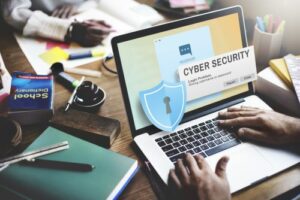How to Keep Your Company and Employees Safe
 I wrote an article a few weeks ago outlining simple tasks that could be implanted to protect personal information. Today, I want to follow that article up with one targeted toward businesses. As a professional IT security consulting firm, we perform IT risk assessments all the time for companies. Unfortunately, we see the same risks in most environments. In this blog post, I will explore steps that companies can take to enhance cybersecurity in the workplace and keep their valuable assets secure.
I wrote an article a few weeks ago outlining simple tasks that could be implanted to protect personal information. Today, I want to follow that article up with one targeted toward businesses. As a professional IT security consulting firm, we perform IT risk assessments all the time for companies. Unfortunately, we see the same risks in most environments. In this blog post, I will explore steps that companies can take to enhance cybersecurity in the workplace and keep their valuable assets secure.
- Employee Education and Awareness – One of the most critical aspects of maintaining proper cybersecurity hygiene in the workplace is to educate and raise awareness among employees. Many cyber-attacks are the result of human error or lack of awareness, such as falling victim to phishing scams or downloading malicious files. Companies should implement comprehensive cybersecurity training programs to educate employees about the potential threats and best practices for safeguarding sensitive information. Regularly update training materials to keep up with the latest trends and encourage employees to report any suspicious activity promptly.
- Strong Password Policies – Weak passwords remain a common vulnerability in many organizations. Implementing a strong password policy is an effective way to mitigate this risk. Encourage employees to create complex passwords consisting of a combination of uppercase and lowercase letters, numbers, and special characters. Enforce regular password changes and discourage the reuse of passwords across multiple platforms. Implementing multi-factor authentication (MFA) adds an extra layer of security, making it significantly more challenging for attackers to gain unauthorized access.
- Secure Network Infrastructure – Secure network infrastructure is a vital aspect to protect sensitive information from unauthorized access. Companies should ensure that their networks are protected by installing robust firewalls, intrusion detection systems, and up-to-date antivirus software, and collect and monitor logs. Regularly update all software and firmware to patch any vulnerabilities. Consider implementing a Virtual Private Network (VPN) for secure remote access to company resources. Secure Wi-Fi networks with strong encryption and regularly change default router passwords.
- Data Encryption and Backup – Data encryption plays a crucial role in preventing unauthorized access to sensitive information. Encrypt all sensitive data, both in transit and at rest, to ensure that even if it falls into the wrong hands, it remains unreadable. Regularly back up critical data to an off-site location or a cloud-based service. This practice helps to mitigate the impact of ransomware attacks, hardware failures, or accidental data loss. Test data restoration regularly to ensure backups are functioning correctly.
- Regular Software Updates and Patching – Cyber attackers often exploit vulnerabilities in outdated software. Companies should establish a rigorous patch management process to keep all software, operating systems, and applications up to date. Enable automatic updates whenever possible, and regularly check for new patches and security updates released by software vendors. Promptly install patches to address any identified vulnerabilities, reducing the risk of exploitation by attackers.
- Incident Response and Recovery Plan – Despite the best preventive measures, cyber incidents can still occur. Developing a comprehensive incident response and recovery plan is essential to minimize the impact of a cybersecurity breach. This plan should include clear guidelines for identifying, containing, and eradicating cyber threats, as well as a communication strategy for notifying relevant stakeholders. Regularly test the plan through simulated exercises to ensure its effectiveness and make any necessary adjustments.
Conclusion
With the increasing sophistication of cyber threats, maintaining a robust cybersecurity posture is crucial for companies to protect their valuable assets and employees. By implementing comprehensive security measures, educating employees, and fostering a culture of cybersecurity awareness, organizations can significantly reduce the risk of cyber attacks. Remember, cybersecurity is an ongoing process that requires continuous monitoring, regular updates, and adapting to emerging threats. By prioritizing cybersecurity in the workplace, companies can create a safe environment and safeguard their sensitive information from potential threats.


